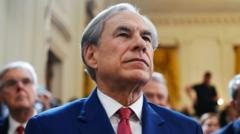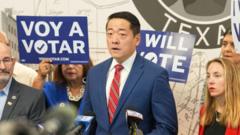The ongoing Texas showdown underscores potential shifts in congressional power and highlights the partisan tactics reshaping the political landscape ahead of the midterm elections.
**Texas Political Maneuvering Threatens Congressional Balance and Trump's Future**

**Texas Political Maneuvering Threatens Congressional Balance and Trump's Future**
A high-stakes clash in Texas showcases the intense political struggle over redistricting as Democrats flee the state to avoid Republican control over electoral maps.
In a dramatic confrontation over redistricting, Texas Democrats have stealthily departed the state to effectively thwart a Republican-led effort that could tilt the balance of power in Congress. Republican Governor Greg Abbott has ordered the immediate arrest of these absent lawmakers and threatened fines of $500 daily, revealing the tensions surrounding an impending vote regarding new congressional boundaries.
The motivation behind this confrontation stems from the Republican agenda aiming to redraw Texas's electoral map, potentially adding five Republican-leaning seats to the U.S. House of Representatives. This crucial event not only holds significance for Texas but could also have ripple effects across other states ahead of the upcoming midterm elections, as both parties vie for greater political influence.
The congressional structure comprises 435 elected representatives, necessitating precise district boundaries that significantly impact the ideological orientation of each area. Currently, the U.S. House is closely divided with 219 Republicans to 212 Democrats, raising the stakes as both parties contemplate the ramifications of redistricting.
Former President Trump is reportedly keen on enhancing Republican prospects in the midterms, particularly within Texas, where he secured a strong victory in the previous election. Lawmakers’ ability to shape district lines offers a crucial strategic advantage, evident in examples from other states where partisan redistricting has significantly influenced election outcomes.
Many Democratic leaders in other states are responding to the unfolding events in Texas, asserting that a similar acceleration of gerrymandering efforts may be necessary to safeguard their interests. California Governor Gavin Newsom and counterparts in New York and Illinois have expressed urgency in amplifying their electoral representation amidst fears of a widening gap in congressional seats favoring Republicans, resulting in calls for aggressive legislative approaches.
While bipartisan commissions often guide redistricting in some states, many areas like Texas afford the ruling party substantial control over the process, raising concerns about fairness and representation. Past precedent for such maneuvers exists; similar strategies were employed in 2003, marking an ongoing struggle for electoral dominance.
As both parties navigate these tactical waters, the risks of backlash against seemingly secure seats could unsettle expectations in close elections. The outcome of the Texas standoff and subsequent redistricting initiatives may prove pivotal not only for state representatives but also for the national political landscape, with repercussions that could reshape the dynamics of Congress and the direction of future legislation.
The motivation behind this confrontation stems from the Republican agenda aiming to redraw Texas's electoral map, potentially adding five Republican-leaning seats to the U.S. House of Representatives. This crucial event not only holds significance for Texas but could also have ripple effects across other states ahead of the upcoming midterm elections, as both parties vie for greater political influence.
The congressional structure comprises 435 elected representatives, necessitating precise district boundaries that significantly impact the ideological orientation of each area. Currently, the U.S. House is closely divided with 219 Republicans to 212 Democrats, raising the stakes as both parties contemplate the ramifications of redistricting.
Former President Trump is reportedly keen on enhancing Republican prospects in the midterms, particularly within Texas, where he secured a strong victory in the previous election. Lawmakers’ ability to shape district lines offers a crucial strategic advantage, evident in examples from other states where partisan redistricting has significantly influenced election outcomes.
Many Democratic leaders in other states are responding to the unfolding events in Texas, asserting that a similar acceleration of gerrymandering efforts may be necessary to safeguard their interests. California Governor Gavin Newsom and counterparts in New York and Illinois have expressed urgency in amplifying their electoral representation amidst fears of a widening gap in congressional seats favoring Republicans, resulting in calls for aggressive legislative approaches.
While bipartisan commissions often guide redistricting in some states, many areas like Texas afford the ruling party substantial control over the process, raising concerns about fairness and representation. Past precedent for such maneuvers exists; similar strategies were employed in 2003, marking an ongoing struggle for electoral dominance.
As both parties navigate these tactical waters, the risks of backlash against seemingly secure seats could unsettle expectations in close elections. The outcome of the Texas standoff and subsequent redistricting initiatives may prove pivotal not only for state representatives but also for the national political landscape, with repercussions that could reshape the dynamics of Congress and the direction of future legislation.

















